| S.No | Question | Option A | Option B | Option C | Option D | Answer | Solution | Comments | Status | Action |
|---|---|---|---|---|---|---|---|---|---|---|
| 1 | Endurance strength of a component does not depend upon which one of the following factors? | Surface finish | Size | Applied load | Cost | d | Endurance strength \(S_{e}âˆShape/size\) \(âˆSurface finish\) \(âˆLoad type\) \(âˆStress concentration factor etc.\) |
Comments | Active | |
| 2 | A cantilever beam of length L carries a concentrated load P at its midpoint. What is the deflection of the free end of the beam? | PL3 / 24 El | PL3 / 48 El | PL3 / 16 El | 5 PL3 / 48 El | d | 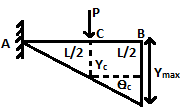 \(Y_{max}=Y_{c}+θ_{c}×\frac{L}{2}\) \(=\frac{P(\frac{L}{2})^{3}}{3EI}+\frac{P(\frac{L}{2})^{2}}{2EI}×\frac{L}{2}\) \((Y_{max}=\frac{WL^{3}}{3EI}, θ_{mox}=\frac{WL^{2}}{2EI})\) \(=\frac{PL^{3}}{24EI}+\frac{PL^{3}}{16EI}\) \(=\frac{5PL^{3}}{48EI}\) |
Comments | Active | |
| 3 | A solid shaft of uniform diameter D is subjected to equal amount of bending and twisting moment M. What is the maximum shear stress developed in the shaft? | 16 M / π D3 \(2\) | 16 M / π D3 \(2\) | 32 M / π D3 \(2\) | 16 M / π D3 | a | Equivalent torsional shear stress. \(τ=\frac{16}{πd^{3}}M^{2}+T^{2}\) \(M=T given\) \(τ=\frac{16}{πd^{3}}M^{2}+T^{2}\) \(=\frac{162}{πd^{3}}M(=\frac{162M}{πD^{3}})\) |
Comments | Active | |
| 4 | Knuckle joint is used to transmit which one of the following type of load | Compressive | Bending | shear | tensile | d | Axial tensile load knuckle joint is used to connect two coincide intersecting non-rotating Shaft. | Comments | Active | |
| 5 | Which of the following properties of mild steel cannot be determined by a static tensile test of the sample | Ultimate tensile strength | Ultimate shear strength | Ductility | Poisson’s ratio | b | Tensile testing is a form of tension testing and is a destructive engineering and materials science test whereby controlled tension is applied to a sample until it fully fails. This test method is used to determine yield strength, ultimate strength, ductility, Strain hardening characteristics Young's modulus and Poisons’ Ratio. For measuring shear Strength three paint loading test is performed. | Comments | Active | |
| 6 | A cast iron sample when tested in compression fails at a compressive stress of 520 N/mm2, what is its shear strength? | 520 N/mm2 | 260 N/mm2 | 210 N/mm2 | 130 N/mm2 | b | Rankine’s Theory according principle stress theory (for brittle material) \(\frac{σ_{1}-σ_{2}}{2}=τ\) \(σ_{1}=520 MPa\) \(σ_{2}=0\) \(∴τ=\frac{σ_{1}}{2}=\frac{520}{2}\) \(=260 N/mm^{2}\) For ductile material shear yield strength \(τ_{sy}=\frac{σ_{y}t}{2}\) For brittle material (approx.) \(τ_{s}y=\frac{σ_{y}c}{2}\) |
Comments | Active | |
| 7 | If the lead angle of a worm is 22 , then the helix angle will be \(\frac{1°}{2}\) | 22 \(\frac{1°}{2}\) | 30 \(°\) | 45 \(°\) | 67 \(\frac{1°}{2}\) | d | Comments | Active | ||
| 8 | The angle of twist in a length l of a shaft when it is subjected to a torque T is equal to | L T / J G | J G/ L T | LT / J G | L G /J T | a | Torsion Equation \(\frac{T}{J}=\frac{GQ}{L}=\frac{Ï„}{R}\) \(Q=angle of twist=\frac{TL}{G.J}\) |
Comments | Active | |
| 9 | The well-known bending formula is | = \(\frac{M}{I}\) \(\frac{E}{R}\) | = \( \frac{M}{R}\) \(\frac{E}{I}\) | = \(\frac{M}{I}\) \(\frac{y}{σ}\) | = \(\frac{M}{R}\) \(\frac{y}{σ}\) | a | Bending Equation \(\frac{M}{I}=\frac{σ}{y}=\frac{E}{R}\) | Comments | Active | |
| 10 | Units of thermal conductivity are | Ns/m2 | W/m K | J/kg °k | none of the above | b | \(Q=-Ka\frac{dT}{dx}\) \(K=\frac{W.m}{m^{2}°K}=\frac{W}{m°K}\) |
Comments | Active | |
| 11 | The moduli of elasticity and rigidity of a linearly elastic isotropic material are 200 GPa and 80 GPa respectively. What is the value of Poisson’s ratio of this material? | 0.30 | 0.28 | 0.25 | 0.22 | c | \(E=2G(1+ν)\) \(\frac{E}{2G}=1+ν=\frac{E}{2G}-1\) \(=\frac{200}{2×80}-1\) \(=\frac{200}{160}-1\) \(=\frac{40}{160}=0.25\) |
Comments | Active | |
| 12 | Which of the following joints is of permanent type | Bolted joint | Rivetted joint | knuckle joint | universal joint | b | Temporary joints allow the easy dismantling of assembled components without rupturing them. Permanents joints don't allow the dis- mantling of assembled components without rupturing them. Bolted joint, knuckle faint, universal joint are temporary. Ravelled joint if need to be dismantled, rivet must be destroyed. | Comments | Active | |
| 13 | When a body is in a state of equilibrium under the action of any force system, the normal stress at a point within the body depends upon | Elementary area ΔA surrounding the point | Elementary force ΔF acting normal to ΔA | The plane orientation containing the point | All of the above | d | 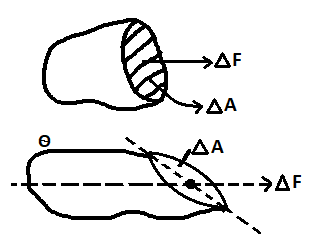 Stress \(σ=\frac{Load}{Area}=\frac{∆F}{∆A}\) \(σ=\frac{∆F}{∆A}\) \(σ=\frac{∆F}{(\frac{∆A}{sinθ})}\) |
Comments | Active | |
| 14 | A heavy uniform rod of length L and material density is hung vertically with its top end rigidity fixe(d) What is the total elongation of the bar under its own weight? \(Ï\) | 2g/ E \(ÏL^{2}\) | g/E \(ÏL^{2}\) | g/E \(ÏL^{2}\) \(2\) | g/ 2E \(ÏL^{2}\) | d | This must give us the required total elongation as ….(1) \(∆l=WL/2AE\) W = mg = = Alg \(Ïvg\) \(Ï\) From eq. (1) \(∆l=ÏALg×L/2AE=ÏgL^{2}/2E\) \(=9.81 ÏL62 /2E\) |
Comments | Active | |
| 15 | In an open coiled helical spring an axial load on the spring produces which of the following stresses in the spring wire | Normal | torsional shear | direct shear | all of the above | b | A helical spring is a wire wound in spiral form, which can undergo considerable deflection without getting permanently distorted. A helical spring is said to be close-coiled when the obliquity of the wire is small, i.e, the pitch of the coils is very small each turn can be regarded as practically lying in planes at right angles to the axes of the helix. Hence, class coiled helical spring is a torsion Spring under axial load it may be assumed that the spring is subjected to torsion only. | Comments | Active | |
| 16 | Chain drive is used for | Short distance | large distance | medium diameter of sprockets | Diameter is not considered | b | Chain drive is used for medium to large distance like in bicycle, bike, Engine, Agriculture machine et(c) It is used for a velocity upto 25 m/s. | Comments | Active | |
| 17 | Circular beams of uniform strength can be made by varying diameter in such a way that | M/Z is constant | /y is constant \(σ\) | E/R is constant | M/R is constant | a | Bending equation: \(\frac{M}{I}=\frac{σ_{y}}{y}=\frac{E}{R}\) Uniform strength of beam. Means (Bending strength is constant throughout) \(σ_{y}\) \(σ_{b}\) \(∵σ_{b}=\frac{M.y}{I}=\frac{M}{I/y}\) \(σ_{b}=\frac{M}{z}=constant\) |
Comments | Active | |
| 18 | Consider the three supports of a beam (1) Roller, (2) Hinged and (3) Fixe(d) The support that permit(s) rotation is (are) | 1,2 and 3 | 1 and 3 only | 1 and 2 only | 1 only | c | Fixed Support – No rotation allow Roller Support – Rotation allow Hinge support – Rotation allow |
Comments | Active | |
| 19 | The relation between E (modulus of elasticity) and k (bulk modulus of elasticity) is | E = k [ 1 - ] \(\frac{2}{m}\) | E = 2k [ 1 - ] \(\frac{2}{m}\) | E =3 k [ 1 - ] \(\frac{2}{m}\) | E =4k [ 1 - ] \(\frac{2}{m}\) | c | \(E=\frac{9KG}{3K+G}=\frac{1}{E}=\frac{1}{9K}+\frac{1}{3G}\) \(E=2G(1+\frac{1}{m})\) \(E=3K(1-\frac{2}{m})\) \(\frac{1}{m}=poisson^{'}s Ratio\) |
Comments | Active | |
| 20 | The bending equation is | = = \(\frac{I}{M}\) \(\frac{σ}{y}\) \(\frac{E}{R}\) | = = \(\frac{M}{I}\) \(\frac{σ^{2}}{y}\) \(\frac{E^{2}}{R^{2}}\) | = = \(\frac{M}{I}\) \(\frac{σ}{y}\) \(\frac{E}{R}\) | = = \(\frac{M^{2}}{I}\) \(\frac{σ^{2}}{y}\) \(\frac{E^{2}}{R}\) | c | Bending Equation \(\frac{M}{I}=\frac{σ}{y}=\frac{E}{R}\) | Comments | Active | |
| 21 | The elongation in a bar due to its self-weight is given by | 9.81 \(Ïl^{2}/E\) | 9.81/2E \(Ïl^{2}\) | 9.81/E \(Ïl\) | 9.81 \(\frac{Ï^{2}}{2E}\) | b | This must give us the required total elongation as ….(1) \(∆l=WL/2AE\) W = mg = = Alg \(Ïvg\) \(Ï\) From eq. (1) \(∆l=ÏALg×L/2AE=ÏgL^{2}/2E\) \(=9.81 ÏL62 /2E\) |
Comments | Active | |
| 22 | The notch angle of Izod impact test specimen is | 10 \(°\) | 20 | \(30°\) | 45 \(°\) | d | 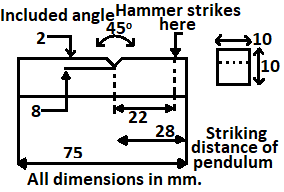 |
Comments | Active | |
| 23 | The diameter of kernel of a hollow circular x-section is | D + d /D | D2 + d2 /D | D2 + d2 /2D | D2 + d2 /4D | d | 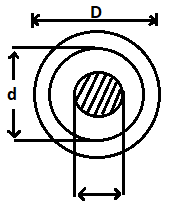 * For solid cylinder it is . \(\frac{D}{4}\) Hollow cycle \(\frac{D^{2}+d^{2}}{4D}\) |
Comments | Active | |
| 24 | In a thick cylindrical shell subjected to internal fluid pressure, the state of stress at the surface is | Three-dimensional | two dimensional | isotropic | none of the above | b | When a thick-walled tube or cylinder is subjected to internal and external pressure a hoop and longitudinal stress are produced in the wall.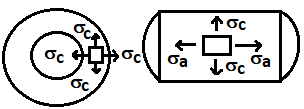 |
Comments | Active | |
| 25 | Modulus of resilience under simple tension is | 2 / E \(σe2\) | / E \(σe2\) | / 2E \(σe2\) | 2 / 4E \(σe2\) Where is the elastic limit stress of the material \(σ_{e}\) |
c | ): Strain energy \(=\frac{1}{2}σ_{e}.E×volume\) \(\frac{Strain energy}{Volume}=\frac{1}{2}σ_{e}.\frac{σ_{e}}{E}\) \(=\frac{σe2}{2E}\) 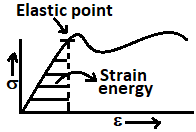 |
Comments | Active | |
| 26 | A football is rolling on ground, the motion of any point on its surface is | Elliptical plane motion | Helical | Spherical | Plane rotation | c | Motion will appear planner but will in actual.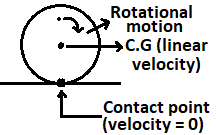 |
Comments | Active | |
| 27 | The motion of a nut on a threaded bolt is | Plane | simple train | spherical | none of the above | a | Planer motion | Comments | Active | |
| 28 | Gear box in a car consists of | Compound train | simple train | epicyclic Gear Train | none of the above | c | Epicyclic Gear train is used watches, Toys, Gear box of auto-mobile etc. | Comments | Active | |
| 29 | The product of circular pitch and diametral pitch of a gear is equal to | Module | unity | π | 1/π | c | Circular pitch (Pc) = \(π\frac{D}{T}\) Diametral Pitch Pd = \(\frac{T}{D}\) \(P_{c}×P_{d}=π\) |
Comments | Active | |
| 30 | In a Hartnell governor, if the stiffness of spring is increased, then the governor will be | More sensitive | less sensitive | hunting | insensitive | b | A governor is said to be sensitive when it readily responds to a small change of speed stiffeners is inversely proportional to sensitiveness. Therefore, if Stiffness is greater, the governor will be less sensitive. | Comments | Active | |
| 31 | Which of the following is not an inversion of angle slider crank mechanism | Crank fixed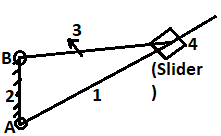 Rotary engine and wet worth quick Return motion mechanism is the Ist inversion of slider crank Mechanism. \(→\) |
Connecting rod mechanism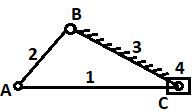 Crank and slotted lever quick return motion mechanism and oscillatory cylinder engine is an 2nd inversion of slider crank mechanism. \(→\) |
Slider fixed Pump (Pendulum) or bull engine is the IIIrd inversion of slider crank mechanism \(→\) 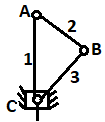 INVERSION OF DOUBLE SLIDER CRANK CHAIN ⇒ It is a Kinematic chain consisting of two turning pairs and two sliding pairs. - Scotch-Yoke mechanism - Elliptical trammel - Oldham coupling |
Oldham’s coupling | d | Inversions of slider crank chain: is obtained fixing links 2,3 and 4. | Comments | Active | |
| 32 | When a slider moves with a velocity V on a link rotating at an angular velocity then the magnitude of Corioli’s component of acceleration is given by \(ω\) | V \(2\) \(ω\) | V \(ω\) | V /2 \(ω\) | 2 V \(ω\) | d | Coriolis component of acceleration=2 V \(ω\) | Comments | Active | |
| 33 | In a belt drive, the pair between belt and pulley is | Higher | lower | spherical | none of the above | a | A wrapping /higher pair is a constraint that comprises belts, chains and such other devices. A belt-driven pulley is an example of this pair. In this type of which is very similar to the higher pair. (which is having point or Line contact), but having multiple point contact so also is said to be wrapping pair. | Comments | Active | |
| 34 | The vee angle in case of vee belts is of the order of | 30 to 34 \(°\) \(°\) | 10 15 \(°\) \(to\) \(°\) | 50 to 60 \(°\) \(°\) | 20 to 30 \(°\) \(°\) | a | The V-belts are made of fabric and cords moulded in rubber and covered with fabric and rubber. These belts are moulded to a trapezoidal shape and are made endless. These are particularly suitable for short drives. The included angle for the V-belt is usually from 50° to 40°. |
Comments | Active | |
| 35 | Efficiency in a normal spur gear pair will be | Above 98% | 70 to 80 % | less than 50% | less than 30 % | a | Type Velocity Ratio ⴄ Range Helical 1:1 to 10:1 98 – 99% Double Helical 1:1 to 15:1 98-99% Bevel 1:1 to 4:1 98-99% Worm 5:1 to 75:1 20-98% |
Comments | Active | |
| 36 | A spherical pair such as ball and socket joint has n degrees of freedom, where n is equal to | 0 | 1 | 2 | 3 | d | The ball and socket configuration allows for movement with 3 degrees of freedom. All will be rotation about 3 axis i.e. x, y and z axis. | Comments | Active | |
| 37 | The principal object of a brake is to | Balance the energy | Give energy | Absorb energy | None of the above | c | Braking is the process of controlling the velocity of an object by inhibiting its motion. A mechanical brakes applies a fiction force to convert the kinetic energy, of the vehicle, to thermal energy which then dissipates as heat into the atmosphere. The principle used by every brake is friction. |
Comments | Active | |
| 38 | In locomotion, the ratio of length of connecting rod to crank radius is kept very large in Order to | Facilitate quick starting | Minimize primary forces | Minimize the effect of secondary forces | Achieve perfect balancing | c | 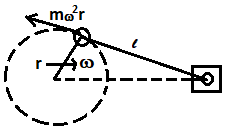 Unbalanced force \(F_{n}=mω ^{2}rcosθ+mω^{2}r\frac{cos2θ}{n}\) Here n = \(\frac{length of connecting rod}{Crank radius}\) \(=l/r\) If l > > r then secondary unbalance force will become negligible. \(\frac{mω^{2}rcos2θ}{n}\) |
Comments | Active | |
| 39 | In petrol engine, governor manipulates | Fuel pump | atomizer | filter | throttle valve | d | 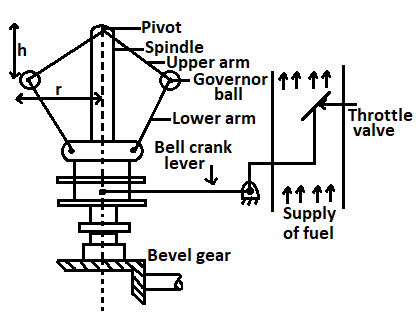 |
Comments | Active | |
| 40 | The working surface above the pitch surface of a gear tooth is termed as | Addendum | dedendum | flank | face | c | 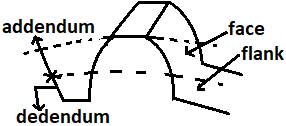 |
Comments | Active | |
| 41 | A simple mechanism has the following number of links | 4 | 3 | 2 | 1 | a | 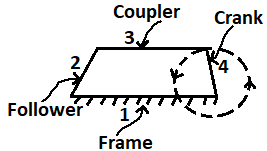 |
Comments | Active | |
| 42 | In a slotted lever quick return mechanism the number of instantaneous centres of rotation | 6 | 10 | 12 | 15 | b | No of links in slotted lever mechanism = 4 No of I- centre = \(\frac{N(N-1)}{2}=\frac{4×3}{2}=6\) |
Comments | Active | |
| 43 | The number of instantaneous centres for a six link mechanism in planer motion is | 30 | 15 | 6 | 6 | b | N = 6 \(I-centre=\frac{N(N-1)}{2}=\frac{6×5}{2}=15\) |
Comments | Active | |
| 44 | The maximum angular acceleration of the connecting rod with crank to connecting rod ratio 1.5 and crank running at 3000 rpm is around | 1.8 x 104 rad/s2 | 9 x 104 rad/s2 | 0.9 x 104 rad/s2 | 3 x 104 rad/s2 | * | As per data given Crank to connected ratio = 1.5 (seems wrong it may be n = 5) N = 1/1.5 For \(α_{max}→θ=90°\) Crank speed (N) = 3000 rpm \(ω=\frac{2πN}{60}=\frac{2π×3000}{60}\) \(=314 Rad/sec\) \(α=\frac{ω^{2}sinθ}{n}=14.79Rad/s^{2}\) |
Comments | Active | |
| 45 | The sensitivity of an isochronous governor is | Infinity | zero | one | two | a | The sensitivity of an isochronous governor is infinity. | Comments | Active | |
| 46 | In a slider crank mechanism, piston velocity becomes maximum for the following configuration when crank is | At inner dead centre | At outer dead centre | Perpendicular to line of stroke | Perpendicular to connecting rod | c |  Velocity of piston \(V_{p}=ωr(sinθ+\frac{sin2θ}{2n})\) r = crank radius = crank speed \(ω\) = Obliquity ratio = 4r \(η\) will be max when \(V_{p}\) \(θ=90°\) \(∴V_{p}=wr (1+\frac{0}{2n})=ωr\) Vp)max @ \(sinθ+\frac{sin2θ}{2n}=1\) |
Comments | Active | |
| 47 | In a four-bar mechanism the following instantaneous center of rotation is not present | Fixed | Permanent | neither fixed nor permanent | Perpendicular to the line joining center of rotations of crank and lever at infinity | d | Fixed instantaneous centre’s = 1 and 2.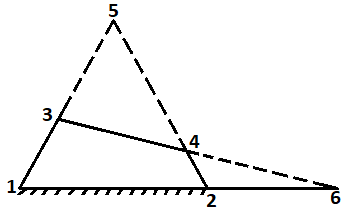 4 bar mechanism Permanent Instantaneous centre = 3 and 4 Neither fixed nor permanent = 5 and 4 |
Comments | Active | |
| 48 | In a slotted lever quick return mechanism, the crank length is 20 cm while the distance between centers of crank and slotted lever rotation is 40 cm. What is the ratio of cutting stroke time to return stroke time? | 2 | 3 | 4 | 5 | a | Crank OA = 20 mm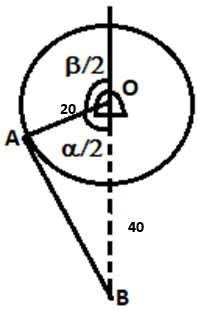 Slotted lever = AB Distance between O and B = 40 mm cos \(âˆ/2=\frac{OA}{OB}\) distance between O and B = 40 mm \(cosâˆ/2 =\frac{OA}{OB}\) \(=\frac{20}{40}\) \(=\frac{1}{2}\) \(\frac{α}{2}=60°\) \(α=120°\) Now \(β=360°-α=360°-120°\) \(=240°\) Now \(QRR=\frac{β}{α}=\frac{240°}{120°}=2\) \(=\frac{Cutting angle}{Retrun angle}\) |
Comments | Active | |
| 49 | The power transmitted by a belt is maximum when the maximum tension in the belt compared to centrifugal tension is | 2.0 times | 2.5 times | 3.0 times | 4.0 times | c | \(T_{max}=3T_{c}\) | Comments | Active | |
| 50 | The radius of gyration of a disc type of flywheel of diameter | D | D/2 | D/ \(2\) | D/ \(3\) | * | MOI)solid disc \(=\frac{1}{2MR^{2}}\) MOI = MK2 K = rgyration Now \(MK^{2}=\frac{1}{2}MR^{2}=K^{2}=\frac{R^{2}}{2}\) \(K=\frac{R}{2}=D/22\) All options are wrong. |
Comments | Active | |
| 51 | For a roller follower, pitch curve and cam surface are | Identical | separated by the radius of the roller | separated by the diameter of the roller | separated by one and half times the radius of the roller | b | 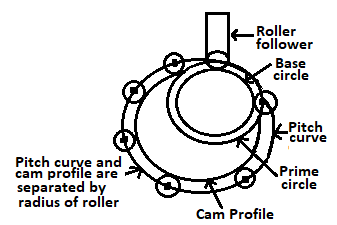 Pitch Curve: It is the curve craven by the trace point (Reference paint on the follower to trace the cam profile) assuming that the cam is fixed, and the trace point of the follower rotates around the cam. The trace point of the roller follower roller is the centre of the Thus for the roller follower. pitch curve and cam surface are separated by the radius of the roller. |
Comments | Active | |
| 52 | In an epicyclic gear train, the number of planets in any given row will be | Equal to 1 | equal to or more than 1 | more than 1 | more than 2 | b | Comments | Active | ||
| 53 | The minimum number of teeth in an involute gear with one module addendum with pressure angle of 14 to avoid undercutting is \(\frac{1°}{2}\) | 32 | 20 | 40 | b | \(η_{p}=\frac{2a}{sin^{2}α}=\frac{2×1}{sin^{2}(14.5)^{0}}=32\) \(a=addendum\) = 1 m |
Comments | Active | ||
| 54 | The pressure angle of flat-footed follower in contact with a circular arc cam is | 5 \(°\) | 3 \(°\) | 0 \(°\) | -1 \(°\) | c | pressure angle:- angle b/w the normal to the pitch point and the direction of follower motion. \(0°\) | Comments | Active | |
| 55 | Normal efficiencies in a single reduction worm gear pair with the velocity ratio 70 would be | Above 98% | 50 to 80 % | less than 30 % | less than 10 % | b | \(η=\frac{Mechanical Advantage}{Velocity Ratio.}\) So \(ηâˆ\frac{1}{V.R.}\) Higher the V.R. lower the efficiency. For 300 : 1- - 49% 5:1 – 98% So here approx. an is 50 – 80% for 70: 1 for calculation we need more data. |
Comments | Active | |
| 56 | The minimum number of teeth of standard proportion with involute profile and 20 pressure angle spur gear is \(°\) | 12 | 18 | 32 | 48 | b | Minimum no of teeth = \(\frac{2}{sin^{2}α}\) \(α=pressure angle\) \(n_{p}=\frac{2}{sin^{2}20°}=18, Full depth gear\) For \(14\frac{1}{5}°\) \(n_{p}=32\) Full depth gear; involute profile. \(4\frac{1}{2}° or 20°\) |
Comments | Active | |
| 57 | In a single involute gear manufacturing the following two are predetermined | Addendum circle and pitch circle diameter | Base circle and addenlum circle diameter | Pitch circle and dedundum circle diameter | None of the above | b | Involute profile is made by a straight line sliding over a base circle without slipping also module is needed tB calculated addendum circle diameter. | Comments | Active | |
| 58 | The normal velocity ratio in belt drive is around | 30 | 10 | 3 to 4 | d | Normal velocity Ratio for Belt drive 3 to 4 – Flat Belt Upto 10 – V-Belt |
Comments | Active | ||
| 59 | The effective coefficient of friction for a vee belt on a pulley is roughly x times that of a corresponding flat belt x = | 3 | 2 | 0.111 | a | V-Belt and flat belt of same width. The area which provides friction between pulley and belt is the area perpendicular to the width of the belt. Since area perpendicular to width of V-Belt is greater than Hat belt approximately 5 times. | Comments | Active | ||
| 60 | Length of crank of a slotted lever quick return mechanism is 150 mm while the distance between centre of crank rotation and slotted lever is 300 mm. What is the ratio of time of cutting to time of return of this mechanism? | 4 | 3 | 2 | 1 | c | Crank OA = 150 mm Slotled lever = AB Distance between O and B = 300 mm cos \(âˆ/2=\frac{OA}{OB}\) distance between O and B = 300 mm \(cosâˆ/2 =\frac{OA}{OB}\) \(=\frac{150}{300}\) \(=\frac{1}{2}\) 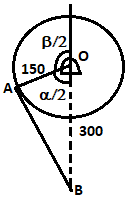 \(\frac{α}{2}=60°\) \(α=120°\) Now \(β=360°-α=360°-120°\) \(=240°\) Now \(QRR=\frac{β}{α}=\frac{240°}{120°}=2\) \(=\frac{Cutting angle}{Retrun angle}\) |
Comments | Active | |
| 61 | How many instantaneous centres of rotation are present in a slider crank mechanism? | 3 | 4 | 6 | 8 | c | In slider Crank mechanism No. of link = 4 = N No of instantaneous centre = \(\frac{N(N-1)}{2}=\frac{4×3}{2}=6\) |
Comments | Active | |
| 62 | A cricket ball of mass 175 gm is moving with a velocity of 36 km/hr. What average force will be required to stop the ball in 0.2 second? | – 5.75 N | – 6.75 N | – 7.75 N | – 8.75 N | d | m = 175 gm = 0.175 kg Initial velocity \(V_{i}=36 km/hr =\frac{36×1000}{3600}m/s\) Force \(=\frac{Change in momentum}{ time}\) [final velocity here Vf = 0] \(=\frac{m(V_{f}-V_{i})}{t}\) \(F= \frac{-mvi}{t}\) \(=\frac{-0.175×10}{0.200}=-8.75N\) (-ve sign shows opposite direction) |
Comments | Active | |
| 63 | A rigid body is acted upon by a couple it undergoes | Translation | translator motion | rotation | d | Couple moment = Pr \(×\)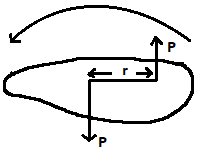 Hence body will rotate, about any point in between pair of force. |
Comments | Active | ||
| 64 | If the momentum of a body is doubled, its kinetic energy will be | Doubled | quadrupled | same | halved | b | Momentum = mass (m) velocity (v) \(×\) And K.E \(=\frac{1}{2}mv^{2}\) [“X†by ] \(=\frac{1}{2}\frac{m^{2}}{m}.v^{2}\) \(\frac{m}{m}\) \(=\frac{1}{2}\frac{P^{2}}{m}\) \(∴2m=constt\) \(∴K.EâˆP^{2}\) \(\frac{KE_{1}}{KE_{2}}=\frac{P^{2}}{(2P)^{2}}=\frac{1}{4}\) \(KE_{2}=4(KE)_{1}\) |
Comments | Active | |
| 65 | 0.01 kilowatt is equal to | 10.0 J/s | 1.0 J/s | 0.01 J/s | a | 0.01 KW = 0.01 103W \(×\) =10W=10J/S |
Comments | Active | ||
| 66 | A rigid body in space has n degree(s) of freedom, when n is | 1 | 2 | 6 | d | 3- translation 3 Rotation |
Comments | Active | ||
| 67 | A body is dropped from rest at height h it comes a distance of gh/25 in the last second. Determine the height h (take g = 10 m/s2 ) | 115 m | 125 m | 126 m | none of the above | d | \(u=0, s=ut+\frac{1}{2}gt^{2}\) ….(1) \(h=\frac{1}{2}gt^{2}\) Let distance covered in (t – 1) sec = d In last second covered distance = gh/25.  Now \(d=h-\frac{gh}{25}\) \(d=h-\frac{10h}{25}=\frac{15h}{25}\) [take g = 10m/sec2] Now, ……(1) \(d=\frac{1}{2}g(t-1)^{2}\) ….(2) \(\frac{15h}{25}=\frac{1}{2}×10×(t-1)^{2}\) …..(3) \(h=\frac{1}{2}×10t^{2}\) (2)/(3) \(\frac{15h}{25}=\frac{(t-1)^{2}}{t^{2}}\) \(\frac{3.9}{5}=\frac{t-1}{t}\) \(3.9t=5t-5\) \(5t-3.9t=5\) \(1.1t=5\) \(t=\frac{50}{111}=4.54sec\) Now, \(h=\frac{1}{2}gt^{2}\) \(=\frac{1}{2}×10×4.54^{2}\) \(=\frac{1}{2}×10×20.6\) \(=103.0m\) |
Comments | Active | |
| 68 | For the maximum range of a projectile, the angle of projection should be | 30 \(°\) | 45 \(°\) | 60 \(°\) | 90 \(°\) | b | \(r=\frac{u^{2}sin2θ}{g}\) RWill be max when \(sin 2θ=1=sin 90°\) Or \(2θ=90°\) \(θ=45°\) 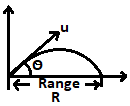 |
Comments | Active | |
| 69 | The total energy possessed by moving bodies | remains constant at every instant | varies from time to time | is maximum at the start | is minimum before stopping | a | According to law of conservation of energy. Total energy will be constant only conversion of energy will occur from one to another. | Comments | Active | |
| 70 | The wheels of a moving car possesses | kinetic energy of translation only | kinetic energy of rotation only | kinetic energy of translation and rotational both | strain energy | c | Due to rotation K.E rotation = \(\frac{1}{2}Iω^{2}\)  Due to translation \(K.E_{translation}=\frac{1}{2}mv^{2}\) |
Comments | Active | |
| 71 | Two bodies of mass m and M are hung at the ends of a rope passing over a frictional pulley. The acceleration in which the heavier mass M comes down is given by the following | g(M – m)/M +m | g(M + m)/M -m | gM /M +m | g x M / M – m | a | \(m  Add both equation \(Mg-mg=Ma+ma\) \(=a(\frac{M_{g}-m_{g}}{M+m})=g(\frac{M-m}{M-m})\) |
Comments | Active | |
| 72 | The bodies which rebound after impact are called | Elastic | inelastic | plastic | none of the above | a | The bodies which rebound after impact are called elastic bodies E.g. Two rubber balls, The bodies which do-not rebound after impact are called inelastic bodies E.g. Two day sphere. | Comments | Active | |
| 73 | The escape velocity on the surface of the earth is | 1.0 km/s | 3.6 km/s | 8.8 km/s | 11.2 km/s | d | The escape velocity from the surface of the earth is ………….(1) \(Ve=(2C_{1}M/R_{E})\) Acceleration due to gravity g = ……..(2) \(c_{1}M/RE^{2}\) Substitute eq (2) in eq (1) we get. \(V_{e}=2gR_{E}, by putting g=9.81 m/s^{2}\) \(R_{E}=6378000 m\) \(V_{e}=11.2 km/s\) |
Comments | Active | |
| 74 | The dimensions of angular velocity are given by | M0 L1 T-1 | M0 L2 T-1 | M0 L0 T-2 | M0 L0 T-1 | d | Unit of angular velocity is per sec (/sec). Dimension = [T]-1 | Comments | Active | |
| 75 | The total momentum of a system of moving bodies in any one direction remains constant unless acted upon by an external force in that direction. This statement is called | principle of conservation of energy | Newton’s second law of motion | Newton’s first law of motion | Principle of conservation of momentum | d | According to principle of conservation of momentum the total momentum of system of masses in any direction remains constant unless acted upon by an external force in that direction. | Comments | Active | |
| 76 | Inertia force of body is expressed as | Product of mass of the body and the acceleration of its center of gravity in the direction of acceleration | product of mass of the body and the acceleration of its center of gravity acting in an opposite direction of acceleration | product of linear acceleration of the body and its mass moment of inertia in the direction of acceleration of its center of gravity | none of the above | b | An inertial force resists a change in velocity of an. object and equal to and in the opposite direction of an applied force, as well as a resistive force. The concept is based on Newton's law of motion inertial force can be examined both when you apply a force, on an object and when a force is applied on you. |
Comments | Active | |
| 77 | If the period of oscillation is doubled | The length of simple pendulum should be doubled | The length of simple pendulum should be quadrupled | The mass of simple pendulum should be doubled | The length and mass should be doubled | b | Time period for SHM \(T=2Ï€\frac{l}{g}\) If \(T_{2}=2T\) \(If l_{1}=l\) \(l_{2}=?\) \(T_{1}=T\) \(\frac{T_{1}}{T_{2}}=\frac{2Ï€\frac{l_{1}}{g}}{2Ï€\frac{l_{2}}{g}}=\frac{T}{2T}=\frac{l_{1}}{l_{2}}\) \(l_{2}=4l_{1}\) |
Comments | Active | |
| 78 | A stone is dropped from a tower 75 m high. At the same time, another stone is thrown upward from the foot of the tower with a velocity of 25 m/s They will | Cross after 1 s | Cross after 2 s | Cross after 3 s | None of the above | c | let after t time both stone crosses stone going downward, Initial velocity u = 0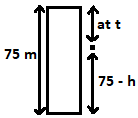 \(h=ut+\frac{1}{2}gt^{2}\) \(=\frac{1}{2}gt^{2}\) Stone going upward. \(75-h=ut-\frac{1}{2}gt^{2}\) \(=25t-\frac{1}{2}gt^{2}\) At meeting point, \(75-\frac{1}{2}gt^{2}=25t-\frac{1}{2}gt^{2}\) \(t=3 sec\) |
Comments | Active | |
| 79 | The maximum frictional force, which comes into play when a body first begins to slide over the surface of another body, is known as | Sliding friction | limiting friction | kinetic friction | rolling friction | d | The maximum friction force that comes into play when body just starts moving is the limiting condition of Static friction. It is also called limiting fiction. limiting fiction: \(F_{max}=μ_{s}N\) |
Comments | Active | |
| 80 | Which of the following represents the state of neutral equilibrium? | Cube resting on one edge | A smooth cylinder lying on a curved surface | A smooth cylinder lying on a convex surface | None of the above | d | A body is said to be in neural equilibrium if on being slightly displaced it remains in its new position e.g., a ball placed on a horizontal surface or a cone supported on its side on a horizontal surface. When the centre of gravity, of a body lies at the point of suspension or support, the body is said to be in neutral equilibrium. Ex: rolling ball. If a ball is pushed slightly to roll, it will neither come back to its original nor it will roll forward rather it will remain at rest.  |
Comments | Active | |
| 81 | The center of gravity of a plane lamina is not at its geometrical center, if it is a | Circle | square | Rectangle | right angled triangle | d | entre of gravity of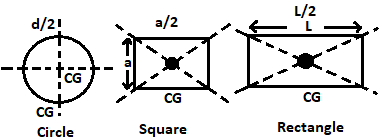 In case of triangle C.G. will be at intersection of medians. 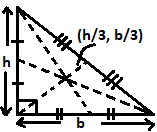 Triangle have multiple geometrical centre. |
Comments | Active | |
| 82 | In actual machines mechanical advantage is | Unity | less than unity | less than velocity ratio | greater than velocity ratio | c | \(∵η_{machine}=\frac{machine advantages}{Velocity ratio}\) And for ideal machine \(η_{machine}=100%\) M.(A) = V.R. But for actual machine \(η_{machine}<100%\) MA < VR |
Comments | Active | |
| 83 | Tangent of angle of friction is equal to | Kinetic friction | limiting friction | friction force | coefficient of friction | c | \(tan (friction angle)=coefficient of friction\) \(=μ\) |
Comments | Active | |
| 84 | Two forces each equal to P/2 act at right angles. Their effect may be neutralized by a third force acting along their bisector in the opposite direction with a magnitude of | P | P/2 | P \(2\) | P/ \(2\) | d | Apply law of parallelogram \(R^{2}=(\frac{P}{2})^{2}+(\frac{P}{2})^{2}+2.\frac{P}{2}.\frac{P}{2}cos 90°\) \(\frac{P^{2}}{2}+\frac{P^{2}}{4}+\frac{2P^{2}}{4}×0\) \(R^{2}=\frac{P^{2}}{2}\) \(R=\frac{P}{2}\) Now if we apply on opposite and equal force R’ will balance the 2 force (given) 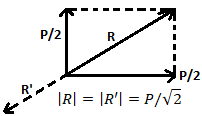 |
Comments | Active | |
| 85 | A body weight of 200 N is resting on a rough horizontal plane, and can be force of 80 N applied horizontally. What will the value of the coefficient of friction? | 0.4 | 0.5 | 0.3 | none of the above | a | Equilibrium is maintained N = W = 200N Now fraction angle. 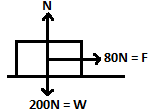 \(tanQ= \frac{F}{N}=μ\) = \(\frac{80}{200}=0.4\) |
Comments | Active | |
| 86 | The resultant of forces = -2 - 3 and = -3 will lie in (quadrants to be reckoned Anticlockwise) quadrant \(p\) \(i\) \(j\) \(Q\) \(i\) \(-4j\) | First | second | third | fourth | c | \(P=-2i-3j\) \(Q=.3i-4j\) Resultant \(R=P+Q\) \(=-2i-3J+(-3i-4j)\) \(=-5i-7J\) 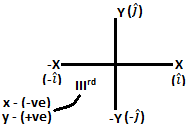 |
Comments | Active | |
| 87 | A rigid body is subjected to non-coplanar concurrent force system. If the body is to remain in a state of equilibrium, then | x = y = z \(F\) \(F\) \(F\) | x = y = 0 \(M\) \(M\) | y = z = 0 \(M\) \(M\) | None of the Above | a | for concurrent force only net force should be zero. Moment of each force will be zero as all forces are passing through same point (concurrent) \(H=0\) \(V=0\) |
Comments | Active | |
| 88 | The velocity of a body on reaching the ground from a height h is given by | =2gh \(ν\) | ν = 2gh2 | = \(ν\) \(2gh\) | \(ν= \) \(\frac{h^{2}}{2g}\) | c | When a body is dropped fem a height h its initial velocity u is zero, let the final velocity on reaching the ground be v. From the formula \(V^{2}=U^{2}+2gh, here u=0\) \(V^{2}=2gh=V=2gh\) |
Comments | Active | |
| 89 | Polygon of forces is useful for computing the resultant of | Concurrent spatial forces | Coplanar parallel forces | Coplanar concurrent forces | Coplanar collinear forces | c | Polygon of forces is useful for computing the resultant of coplanar concurrent forces. Polygon law of forces. It states that if a number of concurrent forces acting on a particle are represented in magnitude and direction by the sides of a polygon, taken in order, than their resultant is represented in magnitude and direction by the closing side of the polygon, taken in' the opposite order. A system of concurrent co-planar forces acting on a particle are: 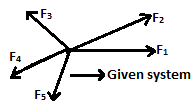 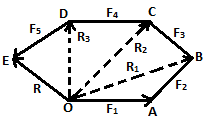 Resultant of given forces. |
Comments | Active | |
| 90 | A ladder rests on a smooth ground against a rough wall, The force of friction acts | Away from the wall at the upper end | Towards the wall at the lower end | Upward at the lower end | Downward at the upper end | b | F1 (Upper end) - along wall upward. 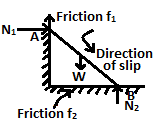 F2 (lower end) - Along the floor towards wall. |
Comments | Active | |
| 91 | If the algebraic sum of the forces acting on a body is zero, then the body may be in equilibrium provided the forces are | Parallel | like parallel | unlike parallel | concurrent | d | Equilibrium \(H=0\) \(V=0\) 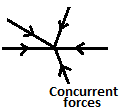 |
Comments | Active | |
| 92 | When a helical coiled spring is compressed axially, it possesses | Potential energy | kinetic energy | mechanical energy | none of the above | a | When you compress or stretch a spring, as soon as the she is relieved, the spring attains its normal shape instantly its elastic potential energy helps to do so. Generally, these elastic substances follow the Hooke's Law, Work done by a coil spring is given by. \(W=\frac{1}{2}KX^{2}\) Where K is the spring constant stiffness X is the extension or compression produced The work done is stored in spring as elasticity energy as, when the spring is compresse(d) |
Comments | Active | |
| 93 | Effect of a force on a body depends upon | Magnitude | direction | line of action | all of the above | d | Effect of force is motion which depends on all 3 given factors. | Comments | Active | |
| 94 | The quantity whose dimensions are M2L2T-3 could be the product of | Force and velocity | Mass and power | Force and pressure | Force and distance | b | MassPower = massforceVelocity \( × \) \(×\) \(×\) = MMLT-2LT-1=M2L2T-3 \(×\) \(×\) |
Comments | Active | |
| 95 | Which of the following statements is correct | The algebraic sum of forces constituting the couple is zero | The algebraic sum of the moments of forces constituting the couple about any point is same | A couple cannot be balanced by a single force | All of the above | a | The main characteristics of a couple 1. The algebraic sum of the forces consisting the couple is zero. 2. The algebraic sum of the moments of the forces constituting the couple about any is the same and equal to the equal to the moment of the couple itself. 3. A couple cannot be balanced by a single force but can be balanced by a couple but of opposite sense. 4. Any number of co-planar forces/couple can be reduced to a single couple whose magnitude will be equal to the algebraic sum of the moments of all couples. |
Comments | Active | |
| 96 | Opening a limca bottle is due to | Moment | Couple | Torque | Parallel forces | a | 2nd It is a kind of lever. In lever moment plays the most important role. • First Class lever-the load is in the middle b/w the fulcrum and the effort. • Third class lever-the effort is in the middle b/w the fulcrum and the load. |
Comments | Active | |
| 97 | In case of concurrent coplanar forces, the conditions of equilibrium are | = 0, = 0, = 0 \(H\) \( V\) \( M\) | = 0, = 0 \(H\) \( V\) | = 0,= 0 \(H\) \( M\) | = 0, = 0 \(V\) \( M\) | b | Algebraic sum of all horizontal and vertical forcer should be zero and algebraic sum of all moment about any point should be zero for coplanar and con-current forces. \(H=0\) \(V=0\) \(M=0\) |
Comments | Active | |
| 98 | Cycle pedaling is an example of | Couple | Moment | Two equal and opposite forces | Two unequal parallel forces | a | Couple: A pair of two equal and unlike parallel forces i.e. forces equal is magnitude, with lines of action parallel to each other. | Comments | Active | |
| 99 | If a body is in equilibrium, then the following is true: | There is no force acting on the body | Resultant of all forces is zero but the moments of forces about any point is not zero | The moments of the forces about any point is zero but resultant of all forces is not zero | Both (b) and (c) | b | A body is an equilibrium only when there is no net external force acting on it.so, in other words, the sum of all forces acting on it must be zero for a beady to be in equilibrium. | Comments | Active | |
| 100 | The coefficient of friction depends upon | Speed of the body | Geometrical shape of the body | Size of the body and nature of contacting surfaces. | Nature of contacting surfaces | d | Coefficient of friction depends on material and nature of contacting surface only. | Comments | Active | |
| 101 | The following is not the characteristics of work sampling | Any interruption during study will not affect the results | The study causes less fatigue | Uneconomical for short cycle jobs | A stop watch is needed | d | No need for stop watch in work sampling. | Comments | Active | |
| 102 | Main objective of work measurement is to | Plan and prepare production schedule | Estimate the selling prices and delivery dates | Formulate a proper incentive scheme | All of the above | d | Objective of work study Compares different Methods Planning and control Realistic costing Plans incentive schemes Cost control etc. |
Comments | Active | |
| 103 | If p = % activity and A = limit of accuracy in work sampling, the number of observations at A confidence level of 95% is equal to the following | (1 – p)/ A2p | 2(1 – p)/A2p | 3(1 – p)/A2p | 4(1 – p)/A2p | d | no of observation = 4 (1 –p)/A2P | Comments | Active | |
| 104 | Group A items constitute the following percentage of items in ABC analysis | 10 to 20 % | 30 to 40 % | 40 to 50 % | 50 to 60 % | a | Group A – 10 to 20% Group B – 30% Group C – 50% |
Comments | Active | |
| 105 | The maximum displacement of a body moving with simple harmonic motion from its mean position is called | Oscillation | Amplitude | Beat | None of the above | b | Repeated, already discussed. | Comments | Active | |
| 106 | For calculating the control limits of P chart the following probability law is used | Binomial | Poisson | Normal | Exponential | a | In statistical quantity control the p-chart is a type of control chart used to monitor the proportion of nonconforming units to the sample. Size n is based on the binomial distribution where each unit has only two possibilities. | Comments | Active | |
| 107 | If A is the total items consumed per year, P is the procurement cost per order and C is the annual inventory carrying cost per item, then which one of the following represents economic order quantity? | AP/C | 2AP/C | \(\frac{2AP}{C}\) | (AP/C )2 | c | Economic order Quantity EOQ = \(\frac{2AP}{C}\) | Comments | Active | |
| 108 | The following is not the guideline for controlling A class item | very strict control | frequent ordering | maximum efforts to reduce lead time | higher safety stock | d | In ABC analysis item A possess neither value nor lower quantity. So very strict controlling is hooded, low storage of this item such that when needed only then it is ordered i.e. frequent order. | Comments | Active | |
| 109 | The number of basic variables in a transportation problem is at the most | m + n – 1 | m + n | m x n | m + n – 1 Where m = numbers of sources, and n = number of destinations |
b | No of basic Variable = m + n - 1 | Comments | Active | |
| 110 | In the model M/M/I : ∞/FCFS the expected queue length is equal to | 1- \(Ï\) Where = utilization factor \(Ï\) |
\(\frac{Ï^{2}}{1- Ï}\) | \( \frac{1}{1- Ï}\) | b | \(Queve Length L=\frac{Ï^{2}}{1-Ï}\) Utilisation factor \(Ï=\frac{mean arrival Rate}{mean service Rate}=\frac{X}{μ}\) |
Comments | Active | ||
| 111 | If annual demand, ordering cost, and inventory cost each become two times, the EOQ will | Remain same | Be half | Become times \( 2\) | Become 2 times | c | Annual demand = D \(D_{1}=D\) \(D_{2}=2D\) Ordering cast = C \(C_{1}=C\) \(C_{2}=2C\) Inventory or holding cast = H \(H_{1}=H\) \(H_{2}=2H\) \(EOQ=Q^{*}\) \(\frac{Q1*}{Q2*}=\frac{\frac{2D_{1}C_{1}}{H_{1}}}{\frac{2D_{2}C_{2}}{H_{2}}}=\frac{\frac{2DC}{H}}{\frac{2.2D.2C}{2H}}\) \(=\frac{1}{2}\) \(Q2*=2Q1*\) |
Comments | Active | |
| 112 | Process in which cross sectional area of bars, rods or tubes in the desired area is reduced by repeated blows is known as | Swaging | piercing | cold peening | extrusion | a | Swaging is a process that is used to reduce or increase the diameter of tubes and on rode. This is done by placing the tube or rod inside a die that applies compressive force by hammering radially. Piercing:- to make hole by shearing Process. Extrusion: a process used to create objects of a fixed cross-sectional profile by pushing material through a die of the desired cross-section. |
Comments | Active | |
| 113 | The following chart shows the consistency of the process | \(X\) | R | C | P | b | The x bar chart is used to evaluate consistency of process average by plotting the average of each subgroup. It is efficient at detecting relatively large shifts (typically plus or minus 1.5 or larger) in the process average. \(σ\) The R-chart on the other hand plot the ranges of each sub- group. The R chart is used to evaluate the consistency of process variation. C-chart is used when identifying the total count of defects her unit (c) that occurred during the sampling period. p-chart is used when each whit can be considered pass fail- no matter the number of defects The X-bar chart shows how the mean or average changes over time and R-chart shows how the range of the sub-groups changes over time. It is also used to monitor the effects of process-improvement theories. |
Comments | Active | |
| 114 | In a transportation problem, the materials are transported from 3 plants to 5 warehouses, the basic feasible solution must contain exactly, which of the following cells? | 3 | 5 | 7 | 8 | c | Here no. of plants = 3 = m No. of warehouse = 5 = n No. of feasible solution = m + n - 1 = 3 + 5 - 1 = 7 |
Comments | Active | |
| 115 | Following are said to be the benefits of assembly line balancing 1. It minimizes the in-process inventory 2. It reduces the work content 3. It smoothens the production flow 4. It maintain the required rate of output Select the correct answer(s) using the code given below |
1,2 and 3 | 2,3 and 4 | 1,3 and 4 | 1,2 and 4 | c | Benefits of line balancing • Improved Process Efficiency • It minimizes the en-process inventory • Increased production rate • It maintain the required rate of output • Reduced total processing time. • Minimum or zero Ideal time. • Potential Increase in profits and decrease in costs. • It smoothens the production flow. |
Comments | Active | |
| 116 | In simplex method, if basic variables satisfy the non-negativity constraints, the basic solution | Is not optimal | Is basic feasible solution | Is basic infeasible solution | does not exist | b | If all the variables assume non-negative values, then the basic solution is feasible. Otherwise, it is infeasible | Comments | Active | |
| 117 | A transportation problem will have feasible solutions if and only if, Where si denotes number of units being supplied by source and dj number of units being received by destination | = \(i=1 ns_{i}\) \(j=1 nd_{j}\) | < \(i=1 ns_{i}\) \(j=1 nd_{j}\) | > \(i=1 ns_{i}\) \(j=1 nd_{j}\) | None of the above | a | for feasible solution in transportation supply equals to demand. | Comments | Active | |
| 118 | Mathematically value of a product is expressed as | Cost/expenses | Cost/utility | utility/cost | none of the above | c | It is calculated by value engineering with the help of product's utility Value engineering is a systematic, organized approach to providing necessary functions. in a project at the lowest cast, Value, engineering promotes the substitution of materials and methods with less expensive alternatives, without sacrificing functionality and also evaluates effective cost. | Comments | Active | |
| 119 | ABC analysis forms part of | Quality control | inventory control | material handling | Methods engineering | b | ABC analysis related to inventory control. | Comments | Active | |
| 120 | The upper control limit of the C chart is | + 3 \(C\) \(C\) | + 2 \(C\) \(C\) | + \( C\) \(2C\) | + \(C\) \(3C\) | a | A c chart is a type of control chart that shows how many defects or non-conformities are in samples of constant size, taken from process. The c chart formulas are: • No. of defects per und C = \(c/n=c/m.\) • Upper combol limit (UCL) = \(C+3C\) • Lower combol unit (LCL) = \(C-3C\) Where • \(summation notation\) • n is the sample size • m is the number of subgraps • C = no. of defects. A c-chart only be the used if the sample size remains constant of sample sizes- aren't constant, use a u chart instead. |
Comments | Active | |
| 121 | Times estimates in PERT are based on | Normal distribution | Hyper geometric distribution | - distribution \(β\) | Binomial distribution | c | In probability and statistics, the PERT distribution is a family of continuous probability distributions defined by the minimum (a), most likely (b) and maximum (c) Values that a variable can take. It is a transformation of the four-parameter Beta distribution with an additional assumption that its expected value is (a + 4b + c) /6 The beta distribution is a probability distribution on probabilities |
Comments | Active | |
| 122 | Classical list of Gilberth’s fundamental hand motions has following number of motions | 5 | 16 | 17 | 20 | c | Effective & Ineffective basic motion elements. Effective• Ineffective • Reach• Hold • Move• Rest • Grasp• Position •Release load• Search • Use• Plan • Assemble• unavoidable Delay • Disassemble• Avoidable Delay • Pre-Position• Inspect • Select |
Comments | Active | |
| 123 | Value Engineering is concerned with saving | time | overhead cost | un-necessary cost | administrative cost | c | Value engineering is a systematic and organized approach to providing the necessary function in a project at the lowest cast. • Value engineering promotes the substitution of materials and methods with less expensive alternatives, without sacrificing functionality. • It is focused solely on the functions of various components and materials, rather than their physical attributes. |
Comments | Active | |
| 124 | If the annual demand is doubled, ordering cost is doubled, holding cost is halved and the unit cost is doubled, then the economic order quantity will be | half | same | twice | four times | c | \(Q^{*}=\frac{2DC_{0}}{C_{H}}\) D = annual demand C0 = Ordering cast CH = Holding cast. \(D_{1}=D \) \(D_{2}=2D\) \(C_{0}_{1}=C_{0}\) \(C_{0}_{2}=2C_{0}\) \(C_{n}_{1}=C_{n}\) \(C_{n}_{2}=C_{n}/2\) \(\frac{Q1*}{Q2*}=\frac{\frac{2DC_{0}}{C_{H}}}{\frac{2×2D×2C_{0}}{C_{h}/2}}=\frac{1}{2}\) \(Q2*=2Q1*\) |
Comments | Active | |
| 125 | The following is not true for the assignment model | xij = 1 | = 1 \(j=1 nx_{ij}\) | = 1 \(i=1 nx_{ij}\) | it can be stated in the form of n x n cost matrix [cij] of real number | a | In this is not true for the alignment model. \(x_{ij}=1 \) | Comments | Active | |
| 126 | Stress concentrations is caused due to | variation in load acting on a member | variation in material properties | abrupt change of cross section | none of the above | c | Stress concentrations occur when there are irregularities in the geometry abrupt changes in c/s area or material of a “Structural component that cause an interruption to the flow of stress. This arises from such details as holes, grooves, notches and fillets, stress concentration may also occur from accidental damage such as niches and Scratches. Abrupt change stress “flow lines†crowd high stress concentration.  Soother change ‘Flow lines’ less crowded Lower less concentration.  |
Comments | Active | |
| 127 | A material shall be called ideal plastic material if | it does not strain harden | it strain hardens | if it is made of plastic | none of the above | a |   |
Comments | Active | |
| 128 | The [110] direction in a cubic unit cell is parallel to | face diagonal of unit cell | edge of the cube | body diagonal of the cube | none of the above | a |  |
Comments | Active | |
| 129 | Vectorial sum of the Burgers vector of dislocations meeting at a nodal point is | zero | 1 | – 1 | none of the above | a | The burger's vector will have the same magnitude and direction over the whole length of dislocation irrespective of the character of the dislocation (edge, screw, on mixed) i.e. Burgers vector is invariant, other geometrical characteristics of dislocations are: vectorial sum of Burger's vector of dislocations meeting at a paint called node, must be zero. |
Comments | Active | |
| 130 | When mechanical properties of a material remain same in a particular direction at each point, such a material is called | isotropic | homogeneous | orthotropic | anisotropic | b | Homogeneous – Same properties in a particular direction at each point. Isotropic – Properties the same no matter what direction you’re looking. Orthotropic – Properties are not some along perpendicular direction only. Anisotropic – Properties are different in each direction. |
Comments | Active | |
| 131 | The ratio of modulus of rigidity to modulus of elasticity of a material for a Poisson’s ratio of 0.25 would be | 0.5 | 0.4 | 0.3 | 0.1 | b | ) \(E=2G(1+μ\) Now \(\frac{E}{G}=2(1+0.25)=2.5\) Or \(\frac{G}{E}=\frac{10}{2.5}=0.4\) |
Comments | Active | |
| 132 | Which of the following is made of ceramic materials? | Heating element | Spark plug | Pyrometer | Furnace linings | d | Furnace lining or tiles. | Comments | Active | |
| 133 | Which of the following material has nonlinear elastic behavior? | Mild steel | Aluminum | Cast iron | Rubber | d | Rubber shows nonlinear elastic behaviour as show in fig. below- Stress – strain curves for two kinds of rubber in tension.  Rubber is a nonlinear elastic material the difference in stiffness of tow rubbers is evident due to a difference in the stop of the curves. Inner surface of furnace is curved by bricks or ceramic tiles et(c) |
Comments | Active | |
| 134 | A material in which the atoms are arranged chaotically is called | Amorphous | Mesomorphs | None of the above | a | Amorphous, ex - Glass | Comments | Active | ||
| 135 | Zn and Mg have the following crystal structure | B. C. C | F.C.C | Diamond cubic | H.(C)P | d | H.(C)P. | Comments | Active | |
| 136 | The imperfection in the crystal structure of metal is called | Dislocation | slip | cleavage | fracture | a | A dislocation is a linear crystallographic defect or irregularity within a crystal structure which contains an abrupt change in the arrangement of atoms. The crystalline order is restored on either side a dislocation but the atoms on one side have moved or slipped. These are of two types 1. Edge dislocation 2. Screw dislocation. The difference between edge and screw dislocation is that the edge dislocation occurs when an extra hay plane of atoms exists in the middle of the crystal lattice whereas the screw dislocation occurs when the planes of atom in the crystal lattice trace a helical path Location line. |
Comments | Active | |
| 137 | Babbit metal is | Lead base alloy | Tin base alloy | Copper base alloy | Lead and tin base alloy | d | There are two types of Babbit materials, fun and lead-based alloys, which also contain antimony, copper, lead and tin in a lesser proportion to the base metal, in accordance with their base metal, reduce the mechanical resistance to friction. Babbit metals for filling bearings, also called babbits or white metals. Ten-based babbit is a material that contains more than 20% of tin alloy. Lead-based babbit is another common bearing material as it will contain 75% or more lead alloy. Tin-based: 88% Tin, 9% Antimony and 2%. Copper (<1% lead) Lead – based : 75% lead, 9% Tin and 15% antimony (1% Arsenic) |
Comments | Active | |
| 138 | The percentage of carbon in low carbon steel is | 0.15 | 0.30 | 0.50 | 0.70 | b | It’s better to select the range of 0.02 to 3% come under low Carbon Steel (Mild Steel) | Comments | Active | |
| 139 | The constituents which most ceramic material contain is | calcium | nitrate | silicate | none of the above | c | Traditional ceramic raw materials include day minerals such as Kaolinite, whereas more recent materials include aluminium oxide, more commonly known as alumina The modern ceramic materials, which are classified as advanced ceramics, include silicon carbide and tungsten carbide. Constituents % by mass. Silicon dioxide. (SiO2) 66.57 Aluminium Oxide (Al2O3) 21.60 Iron Oxide (Fe2O3)1:41 Calcium oxide (Cao)2.41 Sodium oxide (Na2O) 1.41 Potassium oxide (K2O) 2.79 Zirconium Oxide (ZrO2) 1.49 |
Comments | Active | |
| 140 | A material in superconducting state is | paramagnetic | diamagnetic | ferromagnetic | Anti-ferromagnetic | b | Superconductivity is a set of physical properties observed in certain materials where electrical resistance varnishes and magnetic flux fields are expelled from the material. Any material exhibiting these properties is a super conductor unlike an ordinary metallic conductor, whose resistance decreases gradually as its temperature is lowered even down to near absolute zero, a superconductor has a Characteristics critical temperature below which the resistance drops abruptly to zero. * When magnetic flux fields are expelled from the material them material is known as diamagnetic. This type of material have zero susceptibility. * Paramagnetic: very light attraction towards magnetic field. * Paramagnetic: Very light attraction towards field magnetic field. * Ferromagnetic: Strongly attracts towards magnetic fiel(d) |
Comments | Active | |
| 141 | Closed packed planes are formed in | simple cubic crystals | body centered cubic crystals | diamond cubic crystals | face centered cubic crystals | d | Closed pack plane means. Where atomic density is maximum in other words. The plane which have maxi- mum number of atoms or minimum void space, is known as, closed pack plane. These plane appears en FCC and HCP. | Comments | Active | |
| 142 | Very high strength in Aluminum alloys is obtained by | precipitation hardening | solid solution hardening | cold working | annealing | a | Age hardening is a process of increasing strength of non-ferrous alleys like Al, Copper et(c) Precipitation hardening, also called age hardening or particle hardening, is a heat treatment technique used to increase the yield strength of malleable materials, including most structural alloys of aluminium, magnesium, nickel titanium and some steels and The process of age-hardening is executed in a sequence of three steps. First the metal is treated with a solution at high temperatures. The next step is the rapid cooling across the solves line so that the solubility limit is succeeded. Finally, the supersaturated solution is heated to an intermediate temperature in order to the metal is maintained en this state for some time. | Comments | Active | |
| 143 | Energy of a photon is | h ν | h.λ | 1/ h v | v.λ | a | Photon energy is the energy carried by a single photon. The amount of energy is directly proportional to the photons electromagnetic freQncy and thus equivalently, is inversely proportional to the wavelength. The higher the photon’s freQncy the high its energy. \(EâˆÎ½ (frequency)âˆ1/λ (wavelength)\) \(E=hÏ…=h/λ\) Where h = planck constant. |
Comments | Active | |
| 144 | The materials which exhibits the same elastic properties in all directions are called | Isotropic | homogeneous | perfectly elastic | anisotropic | b | Homogeneous - same properties throughout. Isotropic – Properties are same no matter what direction you’re looking. Orthotropic – Properties are same along perpendicular direction only. Anisotropy – Properties are different in each direction.  |
Comments | Active | |
| 145 | A body having same properties throughout its volume is said to be | isotropic | continuous | homogeneous | uniform | c | Its an should be isotropic and homogeneous but in options only homogeneous is given so that is correct. Isotropic Material: If the response of the material is independent of the orientation of the load axis of the sample, then we say that the material is isotropic A material is said to be isotropic when it exhibits same elastic properties in any direction at a given point Homogeneous material. A material is homogeneous if it has same composition throughout body. Hence the elastic properties are the same at every percent in the body Isotopic material can be either homogenises or non- homogeneous.  |
Comments | Active | |
| 146 | The resistance to fatigue of a material is measured by | Elastic limit | young’s modulus | ultimate tensile strength | endurance limit | d | Endurance limit It is defined as the maximum amplitude of completely revered Stress that the standard specimen can sustain for an unlimited number of cycles without fatigue failure. Fatigue Life: It is defined as the number of stress cycles that the standard specimen can complete during the test before the appearance of the first fatigue crack. |
Comments | Active | |
| 147 | By doping, electrical conductivity of a semi–conductor | Decreases | Increase | Remains unaffected | None of the above | b | A semi-conductor material has an electrical conductivity value falling between that of a conductor, such as metal is copper and an insulator, such as glass Its resistivity falls as its temperature rises, metals behave in the opposite way, Its conducting properties may be altered en useful way by inducing impurities (doping) into the crystal structure, when two differently doped regions exist in the same crystal, a semiconductor Function is create(d) The behaviour to of diodes, transistors and most modern electronics. | Comments | Active | |
| 148 | Dielectric materials are used primarily for | Insulation | Charge storage | Reducing electric loss | None of these | b | Dielectrics an capacitors serve three purposes also- 1. To keep the conducting plate’s fem coming in conduct, allowing for smaller plate separations and therefore higher capacitances. 2. To increase the effective capacitance by reducing the electric fluid strength, which means you get the same charge at a lower voltage and 3. To reduce the possibility of shorting out by sparking (more formally known as dielectric breakdown) during operation at high voltage |
Comments | Active | |
| 149 | In a dielectric, the power loss is proportional to | w | w2 | 1/w | 1/w2 | a | Dielectric, loss is loss of energy that goes into heating a dialectic material in a varying electric field, why there is power loss in commercial dielectric? if a dielectric is subjected to an electric field, the electrical energy is absorbed by the dielectric and certain quantity of electrical energy is dissipated in the form of heat energy. This is known as dielectric loss, since it can be seen as here that this Qstion belongs to electrical properties of material , so please try to remember this equation. Power loss per unit volume. PL = wE2 \(∈_{0}∈_{1}\) where = radian freQncy. In given Qstion w = \(ω\) \(ω\) E= Electric field = Relative Permitivity \(∈_{L}\) = Absolute permitivity \(∈_{0}\) |
Comments | Active | |
| 150 | The electrical conductivity of semi–conductor is of the order of | 10-3 mho cm-1 | 10-6 mho cm-1 | 10-8 mho cm-1 | 103 mho cm | b | The materials for electrical application are classified according to their electrical conductivity as: conductors, semi-conductors and insulators dielectrics metals are conductor having conductivities in range of , while semiconductors have conductivities in rage from 10-6 to 104(and materials with conductivity lower than 1010 are termed as insulators. \(10^{7}(Ω-m)^{-1}\) \(Ωm^{-1}) \) \((Ωm)^{-1}\) | Comments | Active | |
| 151 | Which of the following metals has the lowest specific gravity? | Monal metal | copper | Magnesium | Bronze | c | Monal metal specific gravity - 8.80 Copper specific gravity - 8.95 Magnesium specific gravity -1.74 Bronze specific gravity - 8.82 |
Comments | Active | |
| 152 | Slow and progressive deformation of a material with time under constant stress is called | Creep | erosion | resilience | fatigue | a | CREEPÂ -The slow and progressive deformation of a material with time at constant stress is called creep. | Comments | Active | |
| 153 | Nickel is mostly found in | Russia | Canada | Russia and Canada | Russia and India | c | Russia, Canada | Comments | Active | |
| 154 | How many atoms are present in a unit cell of a body centered cubic space lattice? | Six | nine | fourteen | twenty-four | b | Total no. of atoms involved = 9 But no of effective atoms = 2  |
Comments | Active | |
| 155 | The atomic packing factor of BCC metal is | 0.96 | 0.68 | 0.74 | 0.52 | b | APF = \(\frac{N_{atoms}×V_{atom}}{V_{unitcell}}\) \(=\frac{2.\frac{4}{3}πr^{3}}{(\frac{4r}{3})^{3}}\) \(=\frac{π3}{8}≈0.680174\) |
Comments | Active | |
| 156 | An example of amorphous material is | lead | silver | glass | brass | c | Amorphous material don't have any regular arrangement of atoms and not repeatability of this pattern Eg: Glass. |
Comments | Active | |
| 157 | Hooke’s law holds good up-to | proportional limit | yield point | elastic limit | plastic limit | a | Stress and strain take different forms in different situations "Generally, for small deformations the stress and strain are proportional to each other, this is known as Hooke's law. *Hooke's law stales that the strain of the material is proportional to the applied stress within the elastic limit of that material. |
Comments | Active | |
| 158 | The capacity of a material to undergo deformation under tension without rupture is | mechanical strength | stiffness | toughness | ductility | c | In material science and metallurgy, toughness is the ability of a material to absorb energy and plastically deform without fracturing one definition of material toughness is the amount of energy per unit volume that a material can absorb before rupturing. |
Comments | Active | |
| 159 | Ferrites are sub group of | Ferromagnetic material | Ferrimagnetic material | diamagnetic material | Paramagnetic material | b | Ferromagnetic is one mat has population of atom with opposing magnetic moment (unequal), as antiferromagnetism. | Comments | Active | |
| 160 | Heat treatment is done to | Change grain size and soften the metal | Improve electrical and magnetic properties | Relieve internal stresses | All of the above | d | All are functions or objectives of heat treatment. | Comments | Active | |
| 161 | Which one of the following is most important for EDM? | Thermal capacity | hardness | strength | geometry | a | In EDM material semoval mainly depends on thermal proper ties rather than sbergth, hardness. or shape. | Comments | Active | |
| 162 | The mechanism of metal removal in electron beam machining is | Melting and vaporization | Shear | Ion – displacement | Chemical action | a | In LBM and EBM material removal mechanism is melting and vaporization. First material melts and then nearby melting material will vaporize. Three exist four basic non- traditional machining process. (EDM, LBM, EBM and PAM) when thermal energy is utilized to melt and vaporize a liny volume of material from the workpiece although mechanism of material removal is same in all four processes, the source of heat is different. Shear mechanism is used in conventional machining Ion displacement occurs in ECM chemical Action is used in chemical machining. |
Comments | Active | |
| 163 | In USM process the material removal rate is higher for material with | Higher toughness | Higher ductility | Lower toughness | d | USM is mainly suitable for brittle material which have a lower, toughness like glass ceramic, et(c) | Comments | Active | ||
| 164 | The following is not true for the tool life equation | The smaller the value of n steeper the slope of log V-log T line | For ideal tool material n=1 | The larger the value of C smaller is the tool life | The range of variation of n for HSS is 0.08 - 0.20 | a | Speed and tool life with graph. Taylor tool eye Eqn. VTn = c where v = Cutting speed in m/min T= Tool life in minutes n= an index related to cutting tool material For high speed steel tools, n=0.1 to 0.2 for tungsten carbide tools, n=0.2 to 0.4 for ceramic tools, h=0.4 to 0.6 c = a constant It is numerically equally to the cutting speed that gives to life of one minute (C =V*1n=V) To find a steeper curve value of n should be higher n. Gives the slope of log and Log T graph. Ideal tool materials means for any value of cutting velocity tool life will the same always If n=1 product of v and I will be always constant. V Tn=C if n=1, VT=C if the value of material strength constant c is higher, it means strength of material is higher and during Machining hence d of it tool life will be lower. |
Comments | Active | |
| 165 | The value of surface roughness h obtained during the turning operation at a feed f with round nose tool having radius r is given by | f2/4r | f2/8r | f2/12r | f2/16r | b | \(h_{max}=\frac{f^{2}}{8r}\) | Comments | Active | |
| 166 | The following is not true for jigs | These are used on drilling operation only | These guide the tools | These hold the components | Increased machining accuracy | a | A jig is a type of tool used to control the location and or motion of another tool. A jig's primary propose to provide repeatability, accuracy and interchangeability in the manufacturing of products, a device that does both functions (holding the tool and guiding a tool) is called a jig. | Comments | Active | |
| 167 | In ultrasonic machining the tool is vibrated with the following frequency | 50 Hz | 10,000Hz | 20,000 Hz | d | Suitable freQncy of vibration which is used in USM is 20000 Hz or 20 KHz with the help of a transducer. | Comments | Active | ||
| 168 | The current used during EDM is | AC | DC | Pulsed DC | d | Pulsed dc, Current supply is the critical component in the micro EDM for achieving the required parameters of accuracy finish I size of micro holes. Better workpiece material removal and low tool electrode wear can achieve by using appropriate power supply. The EDM power system can be classified into RC, LC, RLC and transistorized types. The transistorized EDM power systems provide. Square wave from pulses with the pulse on-time usually ranging from 1 to 2000 m sec, peak voltage ranging form. 40 to 400V, and peak discharge current ranging from 0.5 to 500 A. The waste piece and tools are two electrodes connected by D.C pulse generator. |
Comments | Active | ||
| 169 | The tool material used in USM is | Mild steel | High speed steel | Carbides | ceramics | a | Comments | Active | ||
| 170 | In EDM the tool is made of | High speed steel | Cast iron | Copper | Plain carbon steel | c | Higher density - for less tool wear and thus less dimensional loss or inaccuracy of tool. • High melting point-leads to less tool wear due to less tool material melting for the same heat load. • Easy manufacture ability • Cast-cheap. • The following are the different electrode materials which are used commonly in the industry • Graphite • Electrolytic oxygen free copper • Tellurium copper-99% Cu +0.5% tellurium • Brass. |
Comments | Active | |
| 171 | In a single point turning operation of steel with a cemented carbide tool. Taylor’s tool life exponent is 0.25. If the cutting speed is halved, the tool life will increase by | Two times | four times | Eight times | sixteen times | d | n = 0.25 \(T_{1}=T\) \(T_{2}=?\) \(V_{1}=V\) \(V_{2}=\frac{V}{2}\) As Taylor’s eqn \(V_{1}T1n=V_{2}T2n\) \((\frac{T_{2}}{T_{1}})^{n}=\frac{V_{1}}{V_{2}}\) \((\frac{T_{2}}{T_{1}})^{0.25}=\frac{V}{\frac{V}{2}}=2\) \(\frac{T_{2}}{T_{1}}=2^{4}=16\) \(T_{2}=16T_{1}\) |
Comments | Active | |
| 172 | The shear angle derived on the basis of minimization of rate of energy consumption is expressed by | - (β – α) \(∅= \frac{π}{4}\) \(\frac{1}{2}\) | - (β – α) \(∅= \frac{π}{2}\) \(\frac{1}{2}\) | - (α – β) \(∅= \frac{π}{4}\) \(\frac{1}{2}\) | - (α – β) \(∅= \frac{π}{2}\) \( \frac{1}{2}\) Where = shear angle \(∅\) α = rake angle β = friction angle |
a | \(∅=\frac{π}{4}+\frac{α}{2}-\frac{β}{2}\) \(∅=\frac{π}{4}-\frac{1}{2}(β-α)\) |
Comments | Active | |
| 173 | Chip velocity (Vc) in machining of metals is equal to | rV | rVs | V/ r | Vs / r Where V = cutting velocity Vs= velocity along the shear plane r = chip thickness ratio |
a | Chip thickness (r) \(=\frac{t}{t_{c}}=\frac{V_{c}}{V}\) [ ] \(V_{c}=rV\) |
Comments | Active | |
| 174 | In metal cutting, Merchant’s circle gives the relationship among various components of | Stresses | strains | forces | velocities | c |  |
Comments | Active | |
| 175 | Taylor’s tool life equation is as follows | TVn = C | VTn =C | (VT)1/n = C | c | Taylor’s tool life Eqn \(VT^{n}=C\) V – Speed of tool T – Tool life n – Taylor’s exponent |
Comments | Active | ||
| 176 | If r = chip thickness ratio, = rake angle, then shear angle is expressed as \(α\) \(∅\) | tan-1 \( \frac{rcosα}{1-rsinα}\) | sin-1 \( \frac{rcosα}{1-rsinα}\) | cos-1 \( \frac{rcosα}{1-rsinα}\) | a | \(∅=tan^{-1}(\frac{rcosα}{1-rsinα})\) | Comments | Active | ||
| 177 | Flank wear occurs mainly on the | Nose part of the cutting tool | Front relief face and side relief face of the cutting tool | Face of cutting tool at a short distance from the cutting edge | Both (a) and (b) above | d |  |
Comments | Active | |
| 178 | The relationship between the shear angle φ, friction angle β, Rake angle , and the machining constant C for the work material is \(α\) | 2 + \(∅\) \(β- α=C\) | 2 = C \(α+ β- ∅\) | 2 \(β+ α- ∅=C\) | 2 \(∅+ α+ β=C\) | d | \(2∅+β-α=C\) | Comments | Active | |
| 179 | The hot forging of steel specimen is carried out at a temperature of | 400C \(°\) | 600C \(°\) | 500C \(°\) | 950C \(°\) | d | It should be above 800 as steel’s recrystallization temperature is 800. \(℃\) \(℃\) | Comments | Active | |
| 180 | The following is true for “GO†and “NO GO†gauge | Plug gauge can measure the dimensions of a hole | Wear allowance is provided on “NO GO†end | “GO†end is smaller than “NO GO†end | Gauge tolerance is 10% of manufacturing tolerance | d | A go/no-go gauge refers to an inspection tool used to check a workpiece against its allowed tolerances via a go/no-go test, its name is derived from two tests the check involves the workpiece having to pass one test (go) and fail the other (no-go). It does- not measure, wear allowance is provided on "Go gauge" Gauge tolerance is 5%-10% of manufacturing Go is always tolerance not always smaller than No Go. | Comments | Active | |
| 181 | With high-speed steel tools, the maximum safe operating temperature is of the order of | 200C \(°\) | 540 \(°C\) | 760 \(°C\) | 870°C | b | Low carbon steel - 250 \(℃\) HSS – 550 \(℃\) Carbide - 1000 \(℃\) Ceramic - 1200 \(℃\) |
Comments | Active | |
| 182 | How many elements define the tool signature? | Two | Four | Five | Seven | d | Tool signature \(α_{b}-α_{s}-r_{e}-r_{s}-c_{e}-c_{s}-R(in min)\)    |
Comments | Active | |
| 183 | Crater wear occurs due to which one of the following phenomena? | Adhesion | Diffusion | Oxidation | All of the above | b | Crater wear is formed due to the high velocity chip flow (hot and serrated chips) over the tod rake face, and occurrence of flank wear is withessed over the flanck face due to tool-work abrasion. The crater wear is mainly due to diffusion and abrasion, they are commonly used observed where the continuous chip is formed (usually in the ductile material) | Comments | Active | |
| 184 | The angle made by the tool face with a plane parallel to cutting tool base is known as | Rake angle | cutting angle | clearance angle | lip angle | a | Important Teams of single print cutting tool. Side rake angle:   ⇒ seven element defining the tool signature. |
Comments | Active | |
| 185 | If the cutting speed is increased, what will happen to the built – up edge | It becomes longer | It becomes smaller and may vanish later | It does not form | Has no relation to speed | b | Higher the cutting speed lower the chances of formation of built up edge. | Comments | Active | |
| 186 | Discontinuous chips are formed during machining of which of the following materials? | Brittle metals | ductile metals | soft metals | hard metals | a | favorable condition of making discontinuous chips - Brittle material - low back rake angle - Higher feed and depth of cut - Low cutting speed - Absence of cutting fluid |
Comments | Active | |
| 187 | Following electrolyte is used in electro-chemical machining process | Kerosene | Transformer oil | Brine solution | Water | c | The electrolyte has three main roles in the ECM process; it carries the current between the tool and the workpiece, it removes the products of the reaction, and it removes the heat produced from the of the current | Comments | Active | |
| 188 | For efficient cutting of material with Laser Beam Machining. The material must be | good conductor of electricity | bad conductor of heat | good conductor of heat | good conductor of heat and electricity | b | In LBM material removal take place according to keyhole phenomena So total applied heat on object must be concentrated on a very small area. To increase this effect material should be non-con-ducting of heat. | Comments | Active | |
| 189 | The tool life is affected by which of the following? | Depth of cut | Cutting speed | Feed | All of the above | d | According to taylor's modified tool eye equation. \(TLâˆ\frac{1}{Cutting velocity ×feed ×depth of cut}\) TL is most affected by cutting velocity and least affected by depth of cut. |
Comments | Active | |
| 190 | Micro-geometrical deviations of surface roughness are a series of repeated deviations of a wave with a ratio of pitch to height approximately equal to | 50 | 100 | 500 | 1000 | a | Surface texture includes Youghness, waviness, Jay and flows. * Primary texture <50(Roughnes) \(\frac{l}{h}\) * Secondary texture 250 (Waviness) |
Comments | Active | |
| 191 | Which of the following is not the characteristic of stress-strain curve for mild steel? | The stress is proportional to the strain up to the proportional limit | Percentage reduction in area may be as high as 60-70 % | A neck is formed due to high stress level | During plastic stage no strain hardening takes place | d | Strain hardening always appears is plastic region. |
Comments | Active | |
| 192 | In deep drawing the drawing force (neglecting the friction between the job and the die wall) is approximately equal to | 2πrpt | 3πrpt | 4πrpt | 6πrpt Where rp = radius of the punch t = sheet thickness stress in the direction of drawing \(σ_{z}= \) |
a | , Where \(F=2Ï€r_{p}t\) Or \(=Ï€dt\)  |
Comments | Active | |
| 193 | Diamond pin location is used in fixture because | It does not wear out | It takes care of any variation in center distance between two holes | It is easy to clamp the part on the diamond tips | It is easy to manufacture | b | The diamond shape is a Critical features that helps with machining inaccuracies and smoother locating operatic. | Comments | Active | |
| 194 | The following is not a characteristic of optical comparator | High magnification | Very few moving linkages | Cheap | Optical lever is weightless | c | optical comparators are a type of optical measuring instrument. The measurement principle is similar to that of optical microscopes. Optical comparators are also commonly known as a profile projector or shadowgraph. Advantages of comparator Following are the advantages of optical comparator. 1- High accuracy will be achieved as it has very few moving parts. 2- Less weight than other comparators because of fewer pasts. 3- The parallax error will be avoided. 4- Due to the high magnification, very suitable for accurate measurement can be obtained Disadvantages of optical comparator. Following are the disadvantages of optical comparator 1. A separate power source is required 2. It is not suitable for continuous use due to the scale to be view through the eyepiece 3. It is suitable to use in a dark room only. 4. Optical instruments are expensive. |
Comments | Active | |
| 195 | The following is not the characteristic of explosive forming | Low capital cost of the set up | Very large components can be formed | Only a single die is required | The tooling material is very expensive | d | The main elements involved in a explosive forming process are, The explosive charge an energy transfer medium, a forming die and the work- piece. So tooling of this process is very cheap. | Comments | Active | |
| 196 | Limit gauge | Checks whether the part is made within the specified tolerance | Measures the value of the upper specification limit | Measures the value of the lower specification limit | Measures both upper and lower specification limits | a | limit gauging is a method of checking dimensions in which. a fixed gauge is applied to the work in order to determine whether a given component lies within its limits". Gauges are inspection tools of rigid design, without a scale, which used to check the dimensions of maneyactered components it is a gauge that serves to determine whether the measured part is within prescribed limits of tolerance. | Comments | Active | |
| 197 | In order to locate a rectangular block in a jig or fixture accurately the following number movements must be restricted | 3 | 6 | 9 | 12 | c | By 3-2-1 principle of locating I degree of freedom is restricted The 3-2-1 principle of location (six-point principle) is used to constrain the movement of workpiece along the three axes XX, YY and ZZ. This is achieved by providing six locating points, 3 pins in base plate, 2 pins in vertical plane and 1 pin in a plane which is perpendicular to first two planes. Degree of freedom controlled by 3-2-1 location principle. In this method, I degrees of freedom is controlled.  Pins A,B,C on the base plane (a plane parallel to the plane which- contains x and y axis) restrict the rotation of component about the x-axis and y-axis. It also limits the downward movement of component along z-axis i.e. 1,2,3,4 and 5, degrees of freedom is restricted.  Pins D,E is inn plane parallel to the plane containing x and z axes It prevents the rotation of component about Z axis (6,7 degree of freedom) and the movement of the body is along Y-axis towards one direction.  The last pin F is in a plane parallel to and to plan contains z axes, 2t restricts Y the movement component along X-axis in one direction (8, 9). Three remaining degree of freedom 10, 11, 12 s unrestricted. It facilitates the loading of the component in the fixture. These three degrees of freedom may restrict after loading of component by using clamping device. |
Comments | Active | |
| 198 | The following is not true for jigs and fixtures | Rapid production | Automatic location | Lesser manufacturing cost | Higher speeds cannot be used | c | Jigs and fixture provides. - Interchangeability - Rapid Production - Automation - High Production Rate - Increase of production but it also increases cast of production due to tooling cast. |
Comments | Active | |
| 199 | Explosive forming is used for following | Only for electrical insulators | For large parts typical of aerospace industry | Making very small complex parts | None of the above | b | Explosive forming is a metal wasting technique in which an explosive change is used instead of a punch or press. It can be used on materials for which a press setup would be prohibitively large or require an unreasonably high pressure, and is generally much cheaper than building a large enough and sufficiently high-pressure press. It has been mainly used in his aerospace and aircraft industry to produce large parts for which conventional tooling casts are nigh. It involves the discharge of explosives located at a pre-determined distance from the work piece, and water is generally used as the energy transfer medium. |
Comments | Active | |
| 200 | The deformation rates as high as following are used in high velocity forming of metals | 2 m/s | 25 m/s | 500 m/s | c | HVF or high velocity forming refers to a set of techniques which are used for metal forming. These techniques could include methods such as explosive forming, electromagnetic forming and so forth. All these techniques involve imparting a high kinetic energy to the work piece by accelerating it to a highly velocity, before it is made to hit the appropriate die or made to undergo the process of plastic deformation. Conventional forming Speed →1 to 10 m/s High velocity forming, →10 to 250 m/s, |
Comments | Active |










